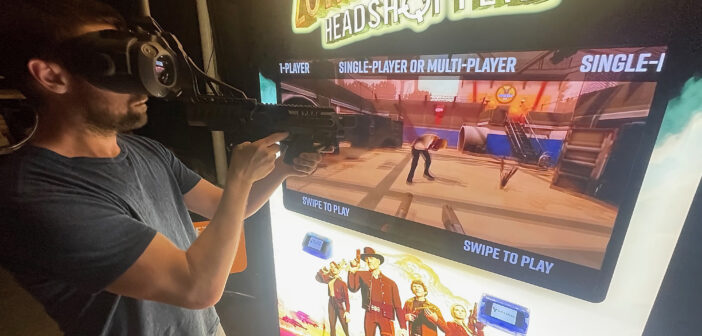Changing the VR Arcade Game
VRsenal Goes All-In for Simplicity & Reliability in Unattended VR Games
by Bob Cooney
Ben Davenport, CEO of VRsenal, is on a crusade to make virtual reality arcade games practical and profitable for operators. Since their first successful product, Beat Saber, VRsenal continues to turn operator requests into practical VR solutions.
In the last six months, VRsenal has unveiled a new unattended VR cabinet platform, a new zombie shooter based on a blockbuster Hollywood IP, a new music rhythm game that rates higher on PlayStation VR than Beat Saber, and a new VR cable solution that eliminates the headset HDMI cable, solving the biggest headache for VR operators everywhere.
To understand how VRsenal became what I believe is the most innovative company in location-based VR, how they impact the industry, and why I came to work with them, it’s essential to set some context and backstory.
You can tell an innovator by how many people try to emulate them. VRsenal was the first company to produce a cabinet with a ruggedized VR headset to withstand the abuse inherent in arcades. They were the first to create a headset retraction system to protect the fragile HDMI cable. They were the first to bring certified blockbuster VR titles to arcades. And now they’re the first to create a headset and cable solution warrantied to last two years.
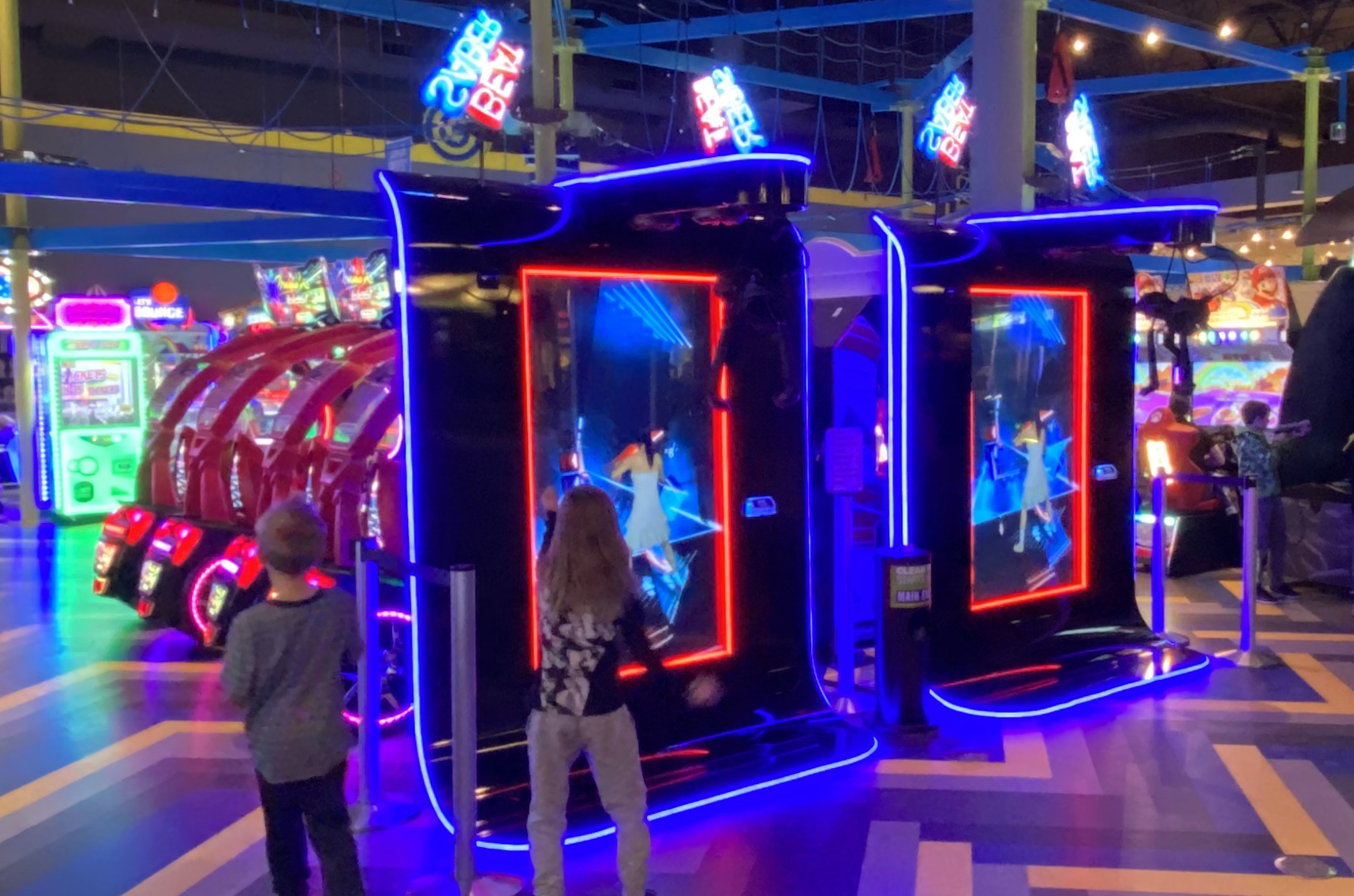
VRsenal’s first product was a VR arcade version of the popular Beat Saber consumer game (it’s pictured on location at a Main Event). When Facebook bought the developer of the game, they pulled the license for arcade VR meaning that no new units could be built. Fortunately, VRsenal had secured the license in perpetuity for all units already built and in the field ensuring operation going forward.
Beat Saber Debuts
My first conversation with Ben Davenport was at IAAPA Orlando in 2018. VRsenal had unveiled a new standalone VR cabinet featuring Beat Saber, the first verifiable smash hit for the home VR market. The cabinet featured an automated retraction system that raised and lowered the HTC VIVE headset. It also sported rugged armor to protect the headset from breaking. It was the first unattended VR arcade game, and it was the talk of the show. (LAI Games’ VR Rabbids: The Big Ride was the first unattended VR simulator, but I didn’t categorize it as a “game” since there was no player interaction.)
I ran into my friend and arcade icon Michael Getlan at the show. He was among the first to buy Beat Saber and was going to put it in his New Roc City arcade in New Rochelle, N.Y. Michael was notoriously hard to please, but he was so excited. He rarely jumped on a new product without testing it first. But he was in love with it.
I told him he was crazy. In 2018, VR was still new and VRsenal was an unproven company. The product was expensive too. But, I am always willing to be wrong.
Soon Main Event jumped on Beat Saber too. The bowling-centric FEC chain rolled it out across the country in the summer of 2019. Shortly after, I received an email from Linda Fernandez, the matriarch of the arcade business, asking me what I thought of VRsenal. I told her I would do some research.
I reached out to Getlan first. He was thrilled after some initial bumps in the road with the first unit. “I’ve never gotten better support from a company in my life,” he exclaimed, telling me how VRsenal flew an engineer out to his location to evaluate and fix early production issues on the spot.
Steve Klohn, CIO for Main Event, echoed Michael’s comments. When I asked him how he got comfortable with such a large purchase from a new company, he said, “I did my due diligence and the product earns so well, we are getting our investment back in six months.” Beat Saber became a hit in arcades and cemented VRsenal as a leader in the burgeoning VR arcade game business.
All Good Things Must End
Beat Saber was such a hit on the consumer market that Facebook, maker of the Oculus Quest headset, acquired the developer for an undisclosed sum. That investment would let Beat Games use more hit music from major artists like Billie Eilish, Lady Gaga, and Imagine Dragons. The licensing environment for out-of-home music is complex, and the market for arcade games is relatively small. Soon after the acquisition, they notified VRsenal that they would not renew the license upon expiration. Fortunately for operators, VRsenal negotiated perpetual game licenses for the cabinet’s life. Existing operators could enjoy making money with Beat Saber forever.
But VRsenal needed a new hit title to keep the factory running.
Enter, The Force
ILMxLAB, the immersive gaming division of Disney’s LucasFilm, created a series of Star Wars games for the Oculus Quest called Vader Immortal. It became one of the best-selling titles for Facebook’s Oculus division. Players could explore the Star Wars universe in virtual reality, becoming an apprentice to the Dark Lord Vader.
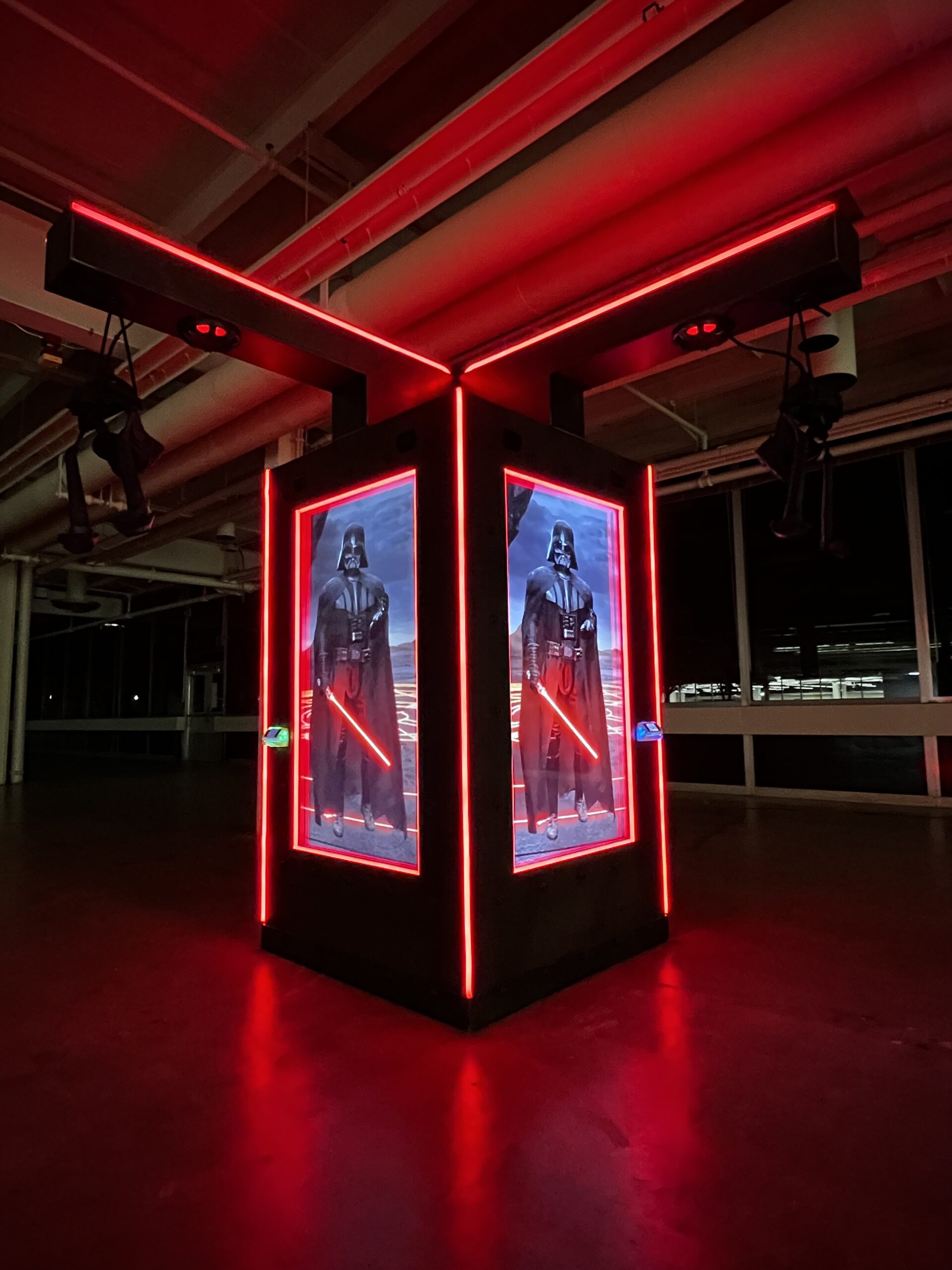
Enter the V2: Covid undermined the launch of VRsenal’s Vader Immortal – Lightsaber Dojo: A Star Wars VR Experience, and while the piece did well, it didn’t reach the levels the team expected. But on a more positive note, the shutdown afforded the opportunity for VRsenal to dive more deeply into improving arcade VR economics. They developed the V2 platform (pictured with the onscreen Dark Lord) which reduced the cost per player by 35% and allowed two units to be placed back-to-back to create a 4-player unattended VR attraction.
One of the mini-games in Vader Immortal was called Lightsaber Dojo in which players learned how to wield the jedi’s weapon of choice and even develop their force skills. It was the ultimate wish fulfillment for millions of Star Wars fans. ILMxLAB was interested in turning this into an arcade game and VRsenal had the perfect hardware platform to bring it to life.
Star Wars has a long history in arcade games. Since the 1983 Atari game, players have fulfilled their jedi fantasies in game rooms for decades. Kevin Bachus, then SVP of Entertainment for Dave and Buster’s, had his own history with Star Wars. A fan himself, he led D&B to their exclusive debut of Namco’s Battle Pod in 2015.
Bachus and Davenport met in late 2018, and a collaboration was born. D&B would be the exclusive home for VRsenal’s new Vader Immortal Lightsaber Dojo: A Star Wars Experience. A national media campaign for Star Wars Day on May 4, 2020, was planned. But the global pandemic had other ideas.
Units did roll out in 2020, but a national promotion was out of the question with Dave and Buster’s stores shuttered nationwide. There were even questions about whether people would use VR again after the hygiene scare of Covid. While those fears turned out to be false, the pandemic did cause the amusement industry to come to a screeching halt.
While D&B deployed Lightsaber Dojo, Ben and his team at VRsenal took advantage of the pandemic shutdown and set about improving the economics of the VR arcade game. While Lightsaber Dojo performed well, Star Wars games have a long history of underperforming in arcades. Lightsaber Dojo didn’t reach the high note of Beat Saber’s collections. And with the licensing cost from Disney and Lucas at 3X the cost of Beat Saber, the price-to-earnings ratio had moved in the wrong direction.
VRsenal tried to shift that value equation. At IAAPA 2021, VRsenal unveiled its V2 system. By accommodating two players, they cut the cost per player by about 35%. And by putting two V2 units back-to-back, operators had the first 4-player, unattended VR attraction.
End of the Cable Nightmare?
While the V2 lowered the cost per player from their single-player system, it retained the complexity of the original retraction system designed to protect the headset cable. But, despite years of engineering and design tweaks, the HDMI cable required for VR headsets remained too fragile for arcade operations.
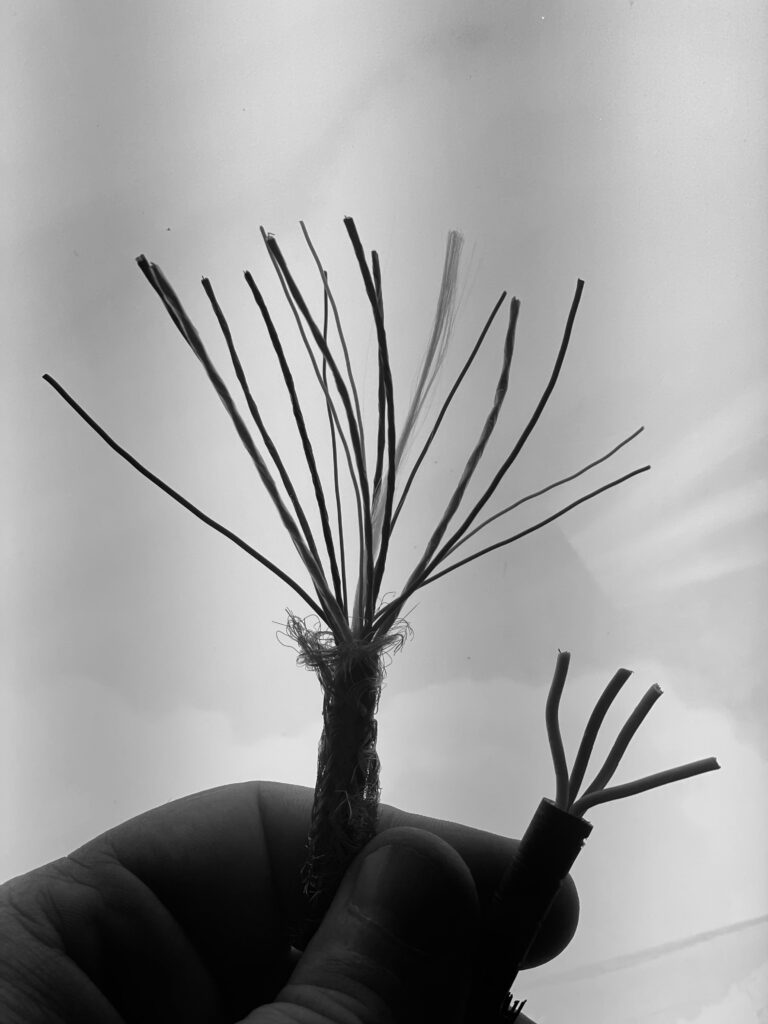
Night and day: At left, the fragile wiring inside an HDMI cable presented headaches for operators, especially during the challenging disruptions of the supply chain. Replacements weren’t cheap either. Working with HTC, VRsenal developed a new, rugged cable solution for the VIVE Focus 3, seen at right above, and were also able to eliminate their headset retraction system.
The cable problem was holding the entire VR industry back. Operators were frustrated with the downtime and expense of repeated cable replacements across their entire VR equipment set. The pandemic-induced supply chain failure exacerbated the issue when HTC fell out of stock of cables for more than six months.
VRsenal started working with HTC on a solution in early 2022. The new VIVE Focus 3 headset opened the opportunity to rethink power, video and data distribution between the computer and the headset. The best way to harden the system was to remove the HDMI cable entirely. VRsenal could then eliminate the retraction system and all the moving parts from the cabinet except the fans.
Dubbed The Monolith, this elegant solution includes custom circuit boards inside the PC and headset armor that handle all the video, audio, tracking data and power. Instead of the 26 hair-thin wires in a standard headset cable, the Monolith uses a durable 4-wire cable proven through a million plays per month on their Star Wars and Beat Saber cabinets.
“Since 2017, the average life of those cables has been two years. This is why we are confident about our two-year warranty for the Monolith cables,” Davenport said.
Dave and Buster’s has converted all their VRsenal games to the new Monolith hardware, eliminating the moving parts inherent with retraction systems. David Boothroyd, director of games and attractions at Humdingers and former senior amusements manager at Dave and Buster’s, oversaw the conversion at multiple D&B locations.
“In the six months that we’ve been deploying the new headset and cable system, not a single headset cable failure has been reported in over 250,000 plays,” Davenport stated.
Feeling that they had finally solved the VR cable problem and eliminated the moving parts, VRsenal set out to address other operator concerns expressed over the years. They created a smaller, compact system that weighs just 275 pounds and takes up only 12 sq. ft. They added a USB port on the top so the operator settings could be accessed without opening the cabinet. And they further reduced the price, making it what I’ve found to be the most affordable VR product that uses top-of-the-line VR gear.
With an entirely new hardware platform, VRsenal had to reload its content library for the post-pandemic recovery. The premature loss of Beat Saber left a hole in the market for a VR music rhythm game. After spending a year working with a new developer from the U.K. on a Beat Saber clone, they could not replicate the original’s magic. Then, a new music game burst onto the consumer VR scene.
Riding the Wave
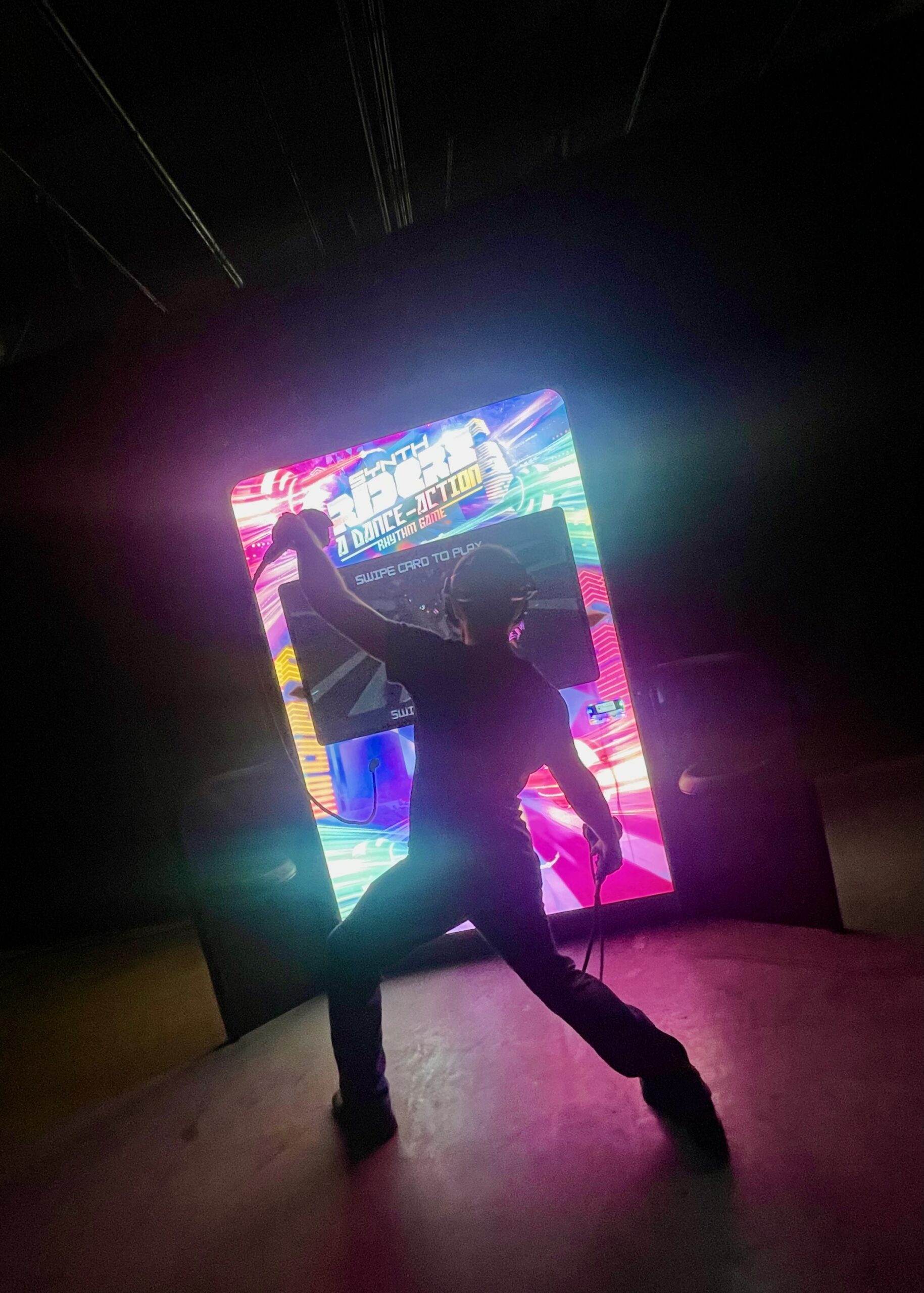
A player gets into the groove with Synth Riders, another title for the new Monolith platform.
Synth Riders from Kluge Interactive was released on Sony’s PlayStation VR in 2021 to stellar reviews. With an 89 on Metacritic, it outscored Beat Saber (which averaged 86) and received the second-highest rating of any PlayStation 4 game that year.
Like many game developers, the team at Kluge Interactive has a love of arcade games. Most gaming executives grew up playing arcade games as kids. When Davenport contacted Kluge CEO Arturo Perez to see if they were interested in turning their hit console game into an arcade game, the answer was an enthusiastic yes!
“The entire Kluge team are gamers at heart,” says Arturo. “Most of us played in arcades growing up. I remember plugging quarters into Killer Instinct when I was a kid. Every game developer secretly desires to see their games in an arcade cabinet.”
Perez continued, “Our players are passionate about Synth Riders. Being in arcades allows them to come out and show off their best moves.”
Where Beat Saber had players aggressively slashing blocks with light sabers, Synth Riders lets players ride waves of music. The difference in experience is striking. Unlike other arcade games, players enter a flow state with Synth Riders. Players groove to the music like a dance game while focusing on the game mechanic of matching their hands to the music waves. It engages both right and left-brain activity.
Jim Bennington, VP of entertainment at Lucky Strike, one of the first amusement chains to install Synth Riders, commented, “The dynamic impact of Synth Riders VR in the arcade for the dance-beat-rhythm community is HUGE! I am so excited to see this title become a standard in all LBE settings. Keep up the excellent work, team Kluge!”
Head Popping Fun
There’s a false narrative in the amusement industry that there are too many VR zombie games. When I researched the most popular games on almost every multi-game VR arcade platform, from Hologate to Zero Latency, zombie shooters are the number 1 genre. And there’s a good reason for that.
It’s been said that the easiest thing to do in VR is to scare someone, and people LOVE being scared. It’s the reason people line up for hours during Halloween to experience a haunted house. VR’s superpower is creating a sense of presence – players feel in the scene so when a zombie gets in their faces, they experience a rush of adrenaline. It’s a visceral, addicting experience that cannot be replicated in a standard 2D arcade game.
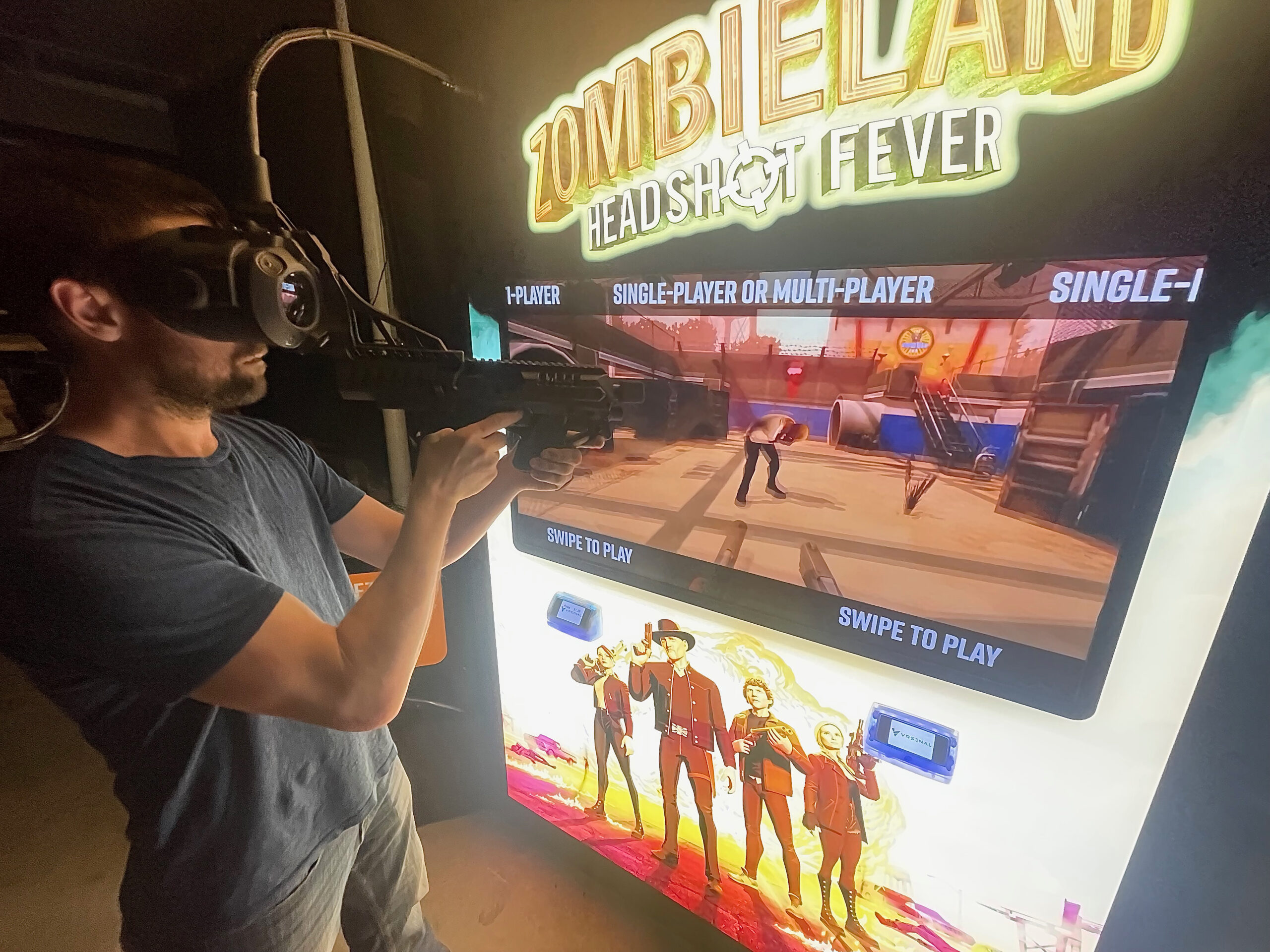
Zombieland Headshot Fever with its headset and gun all-in-one controller (at left) on VRsenal’s Monolith platform facilitates the social head-to-head action the game demands while maintaining a tight footprint for operators.
VRsenal was approached by Sony Pictures to translate their award-winning consumer game, Zombieland: Headshot Fever, into an arcade game. Based on the hit movie series starring Woody Harrelson, Jessie Eisenberg, and Emma Stone, Zombieland VR: Headshot Fever combines the best of light-gun arcade games of the ’90s with split-second racing mechanics.
The gameplay rewards speed and accuracy with a wide range of weapons. Witty banter from the movie’s main characters keeps the intense action on the lighter side. Triggering “Adrenaline Mode” with two quick headshots slows down the world around you, giving players more time to rack up combos and faster times.
“Since Zombieland is a race against time, we made a head-to-head two-player game to encourage more social play,” said Davenport. “The two-player Monolith cabinet allows us to double throughput without increasing footprint, which yields the highest revenue per square metric in the VR arcade game market.”
VRsenal created an innovative way for two people to play safely in such a tiny space. Davenport continued, “We orient the players at a 45-degree angle away from each other. Our integrated gun and headset combination also means their arms are not swinging around, enabling the shoulder-to-shoulder social play they crave. It also facilitates lightning-fast ingress and egress as players pick up the gun, press it to their faces, and are instantly transported into the game. No straps, no buckles, no adjustments. Just pick it up and go.”
According to collection data from the first locations, Zombieland: Headshot Fever Arcade is generating more plays than any other unattended VR arcade system, including the most popular simulators. It’s a testament to the ease of use and accessibility of the new hardware system and the popularity of the IP.
“Our award-winning VR game, Zombieland VR: Headshot Fever, is a natural fit for arcades,” said Jake Zim, SVP of virtual reality at Sony Pictures Entertainment. “VRsenal has built an experience tailor-made for arcade audiences seeking the action, characters and humor from the hit movie franchise coupled with fast-paced, heart-pounding zombie horde gameplay to enjoy in a social setting with family and friends.”
Solving the Pain Points to Grow the VR Market
VRsenal reports that operators have been so happy with the new Monolith headset that they’ve been inundating the company for kits to convert other VR arcade games. So, early this year, Davenport and his team started working on integrating with the most popular unattended VR games on the market.
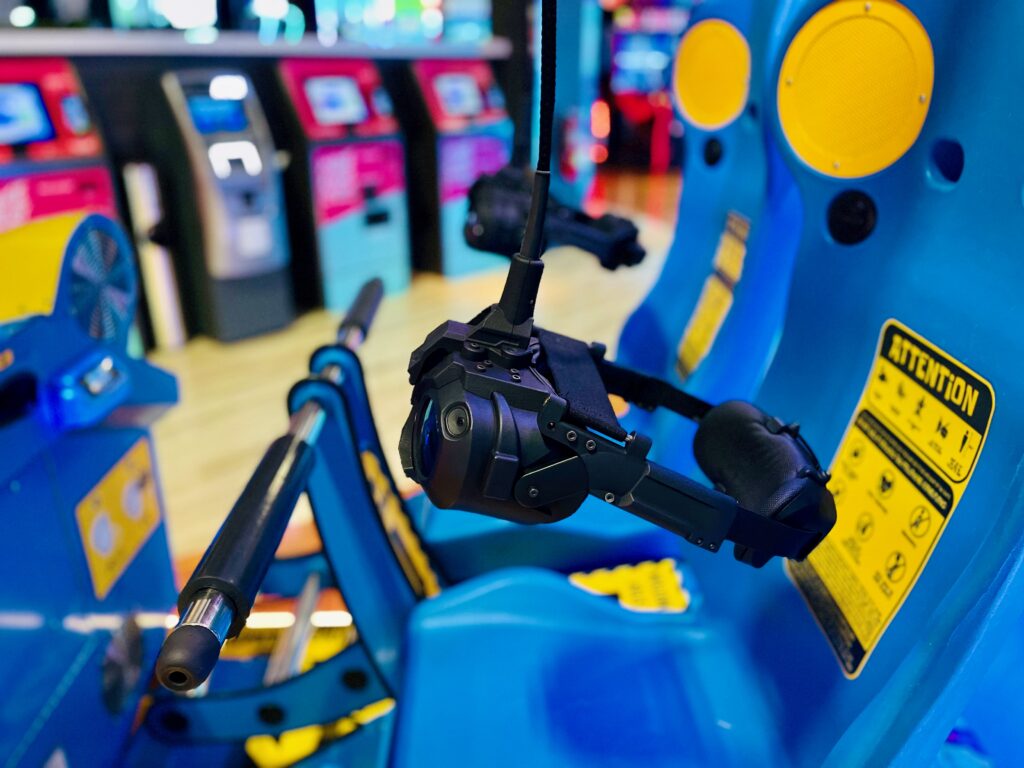
VRsenal is making headset retrofit kits for Virtual Rabbids (above) that come with a 2-year cable warranty. They’re working on kits for other makers’ headsets as well.
“The conversion is simple for VR arcade cabinets that use HTC Vive or VIVE Pro,” he said. “Operators receive a kit with our fully armored modified Focus 3 headsets, our durable, two-year warrantied cables, and all of the software the operator needs for the upgrade. It all comes with detailed instructions and only takes a few hours to install.”
Another benefit of this conversion is that it eliminates the Lighthouse tracking system, which can often suffer component failure or interference from other VR games. This gives operators more flexibility on game placement in the arcade.”
VRsenal started shipping this upgrade kit to select operators of LAI’s Virtual Rabbids: The Big Ride. Davenport says he and his team are also working on upgrades for other VR systems running VIVE headsets. “We will then start converting systems that run on headsets from other manufacturers, like the discontinued HP Reverb,” he added. “Some manufacturers incorporated the Reverb into their VR products because it was inexpensive and didn’t require Lighthouse tracking. But feedback from operators in the field has proven that the Reverb was not rugged or reliable enough for our industry.”
Early adopters of VR arcade games have paid the price of constantly replacing headset cables and other hardware because the games earn, and players love them. The suppliers seemed OK with the status quo, but the products must become bulletproof for VR to “cross the chasm” to the mainstream market. VRsenal is in discussions with major amusement factories about licensing their technology to reduce the burden on operators.
“We want to help everyone solve this problem,” Davenport remarked. “They say a rising tide lifts all ships. We know that if VR becomes easier and more reliable, the VR market will continue to grow, and we will grow with it.”

